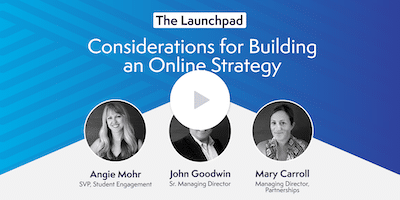Emails Are Still a Powerful Tool in Higher Ed Marketing
In the mid-1990s, a new phrase began triggering internet users’ dopamine receptors: You’ve got mail!
Primarily associated with AOL, the audio alert became one of the hallmark features of online interactions, later going on to transcend its practical origins and become a cultural touchstone led by Tom Hanks and Meg Ryan in the movie that used the phrase for its title.
Almost 30 years later, email remains a foundational aspect of our everyday lives. Unfortunately, many of us have thousands of unread messages, with our inboxes overrun by a host of irrelevant, spammy sales pitches.
When it comes to your higher education email campaigns, you don’t want to be lumped in with the junk.
Email, when used correctly, can still produce positive, productive interactions — just like in the ’90s. Let’s take a closer look at how to create emails that tell an impactful story in higher education.
Outdated Email Campaign Strategies
When it comes to your higher ed institution’s 2024 marketing tactics, you don’t want to be stuck in the past. As you start building out your email campaign strategy, avoid these common pitfalls:
- Text-Heavy Emails: In the digital age, information is consumed quickly and across a variety of formats. Emails with dense text can be overwhelming and off-putting to students. Lengthy paragraphs without breaks, images, or other visual aids can lead recipients to lose interest or not engage with the content at all.
- Lack of Personalization: Today’s students expect communications to be tailored to them. Sending the same generic email to every student ignores their diverse needs, interests, and stages in the educational journey. Personalization goes beyond just inserting the recipient’s name; it involves curating content that resonates with their specific interests, course of study, and relationship with the institution.
- Infrequent or Irregular Cadence: The frequency and timing of emails play a significant role in how and whether students engage with them. Emails sent infrequently may fail to keep your institution in students’ minds, while an irregular cadence can confuse or annoy them. It’s important to find a balance and establish a consistent schedule that keeps students informed and engaged without overwhelming them.
To create effective email marketing campaigns, higher ed institutions need to move away from these outdated strategies. By embracing more modern approaches that prioritize engagement, personalization, and relevance, institutions can craft emails that not only get opened but are eagerly anticipated by students.
Email Campaign Ideas: What Makes a Great Email?
It’s easy to say that emails should be engaging and relevant, but what actually makes an email engaging and relevant? Personalization, optimization, and segmentation.
1. Let’s Get Personal!
Personalization isn’t just a buzzword. It’s a crucial component of successful email campaigns, especially in higher education.
To personalize your emails effectively, start by collecting and analyzing data on your students’ academic interests, engagement histories, and stages in the educational journey. Use this information to segment your email list into different groups, such as prospective students, current students, and alumni, and further refine these groups based on their specific interests and needs.
Once you’ve got your segments, craft your emails with content that speaks directly to each audience, addressing their unique concerns and highlighting opportunities that are appropriate for them. Incorporate personal touches, like using the student’s name, referencing their field of study, or mentioning recent campus activities they’ve participated in.
Additionally, you should leverage automation tools to trigger emails based on the student’s specific actions or milestones, such as when they request information, apply for admission, or register for classes.
Here are some ways personalized emails can significantly impact a campaign’s effectiveness:
Increased Engagement
Tailoring content to the specific interests and needs of students transforms generic broadcasts into engaging, meaningful conversations.
Relevance to Individual Needs
Students have unique goals and interests at different stages of their academic journey. Personalization ensures the content they receive is relevant to them, whether it’s about orientation, graduate programs, career services, or campus events.
Higher Open and Click-Through Rates
Using the recipient’s name and focusing on their interests boosts the likelihood that emails will be opened and acted upon.
Better Relationships
Personalized communications foster a strong connection between students and the institution, enhancing students’ satisfaction and their overall college experience.
Effective Communication
In a sea of emails, those tailored to the student stand out, demonstrating the institution’s respect for their time and interests.
Increased Student Success
Delivering information and resources aligned with students’ individual needs supports their academic and personal achievements.
Enhanced Technological Satisfaction
Today’s digital-native students expect personalization as part of their online experience. Institutions that fail to provide this may appear out of touch.
You should regularly update your data and refine your segmentation strategy to keep pace with changes in your audience’s interests and needs, ensuring your emails remain personalized and impactful.
2. Designing Emails for the End User
According to eMarketing Institute, 55% of all emails are opened on a mobile device — and that’s just the tip of the iceberg when it comes to meeting your audience where they are. Follow these tips to ensure that your emails are optimized:
Mobile Optimization
With students frequently accessing emails via smartphones and other mobile devices, you’ll need to make sure your design is responsive. Emails should automatically adjust to fit the screen size of the device to maintain their readability and functionality.
Accessibility Features
Consider the diverse abilities of your audience. Implementing accessible design principles — such as clear fonts, high contrast, and logical layouts — not only supports students with disabilities but also enhances readability for everyone.
Inclusion and Support
By designing with accessibility in mind, you’re demonstrating your institution’s commitment to inclusion and equality. This approach ensures that all students, regardless of their abilities, can access and benefit from your communications.
Longevity
As digital standards evolve, starting with an accessible design ensures your communications remain relevant and effective. Adapting to future technology changes becomes simpler when accessibility is a foundational element of your email campaigns.
Designing emails with the end user in mind — considering both the diverse needs of your audience and the variety of devices they use — results in more inclusive, engaging, and future-proof communications.
3. The Art of the Subject Line
Crafting the body of your email is important, but the effort is lost without a great subject line that entices students to open it. To craft a subject line that captures students’ attention, consider the following areas:
Clarity and Suitability
Your subject line should be a transparent window into the email’s content, directly addressing the student’s interests or needs to immediately grab their attention.
Brevity
Aim for conciseness, keeping the subject line to around 50 characters or less. This is especially important for students using mobile devices, where screen space is limited and longer text may be truncated.
Personalization
Incorporate the student’s name, major, or year in the subject line. This signals that the email contains information tailored specifically to them, increasing the likelihood that they’ll consider it worth reading.
Including Questions
Pique students’ curiosity by posing a question related to their experiences or challenges. A well-crafted question can intrigue and motivate students to seek answers within your email.
Testing and Optimization
Utilize A/B testing to experiment with different subject lines, analyzing the open rates for each to identify what resonates with your audience. Continuously refining your approach based on metrics will improve your strategy over time.
Cultural and Campus Relevance
When appropriate, weave in references to current events, pop culture, or campus happenings. Making a connection to the broader context of the student’s world can enhance the email’s appeal.
Using Audience Segmentation Strategies in Email Campaigns
Now that you understand what it takes to create a compelling subject line and engaging and accessible email content, let’s make sure you’re sending the email to the right person.
Using audience segmentation in email campaigns enables your higher education institution to refine its communication strategies, ensuring messages are both targeted and appropriate. As a result, engagement levels rise, since students are more inclined to interact with content that speaks directly to their personal experiences and needs.
Segmentation also leads to a more efficient use of your marketing and communication resources. By identifying and focusing on specific groups of students who will benefit most from particular messages or offers, your institution can optimize its marketing and budget allocation efforts.
This targeted approach not only supports students’ success by addressing their unique needs — such as providing first-year students with crucial information on campus resources or guiding seniors toward career services — it also enhances your institution’s ability to collect accurate data on students’ preferences and behaviors. These insights are invaluable for refining future communication efforts and improving students’ overall experience.
Segmentation fosters a strong sense of community among students with shared interests or academic paths as well, which is particularly beneficial for promoting extracurricular activities and events. As a crucial step toward achieving a higher degree of personalization in your communications, segmentation can significantly impact the relevance and effectiveness of the messages you send to students.
Prioritize Your Email Campaign Strategy
When you personalize, optimize, and segment your email campaign strategy, your higher education institution can engage and retain students — which should be your ultimate goal.
Archer Education specializes in elevating students’ engagement through thoughtful, data-driven strategies. Contact our team and see how you can implement better outreach strategies at your school today.



